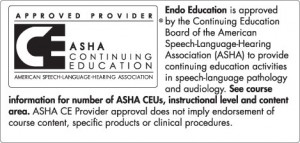Course Description
This lecture is designed to provide participants with a heightened understanding of the impact of respiratory disease and an artificial airway on voice and swallowing function. A review of the dynamics relating to respiratory failure and the need for tracheostomy tube placement will be provided. This will be accompanied by discourse on basic ventilator applications that include relevant settings/modes and the related impact on spontaneous breathing ability. Objective evaluation techniques to be employed with this population will be accompanied by restorative and rehabilitative clinical techniques that serve to enhance functional communication and safe swallowing ability. Audio and video examples will be provided in order to emphasize clinical efficacy of these techniques.
Time ordered agenda
20 minutes – respiratory basics
20 minutes – introduction to artificial airways
40 minutes – impact of artificial airway on voice and swallowing ability
40 minutes – diagnostic and treatment considerations
Learning Objectives
1) Define 3 different modes of mechanical ventilation and the related impact that they have on spontaneous breathing
2) Demonstrate understanding of 3 key principles (pressure, sensation and respiration) that have impact on functional voice and swallowing abilities
3) Identify the chief benefits of a dedicated “trach team” on weaning, decannulation and functional swallowing ability
4) Generate a plan of care for the tracheostomy/ventilator dependent patient with both short and long term goals
5) Describe optimal diagnostic models that would be employed with this population and elaborate on nuances of expected outcomes with each type of evaluation (FEES, MBS, Bedside)
Disclosures
Liza Blumenfeld
Financial: Owner, Endo Education
Non-financial: Nothing to disclose
